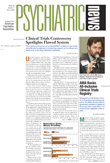Greater buying power for individuals and greater choice among health insurance plans in more, and more diverse, markets—that's the AMA's vision for reforming the American health care system.
A health system reform proposal focusing on tax credits to expand purchasing power by individuals and incentives to form new private insurance markets beyond employer-provided plans is spelled out in a “Special Communication” that appears in the May 12 Journal of the American Medical Association.
AMA President Donald J. Palmisano, M.D., who is lead author of the article, cited the proposal in his opening address at the 2004 Annual Meeting of the AMA House of Delegates last month in Chicago.
Emblematic of the AMA's decades-long opposition to“ government-controlled” health care, Palmisano took pains to note in his address that the proposal specifically cautions against a single-payer system.
“Under [a single-payer] scheme, the U.S. would trade the uninsured issue for an entirely new set of problems that lead to far worse consequences,” he said. “Long waits for health care services, rationing of care, resistance to adopting new technologies, and a mushrooming bureaucracy can snatch control of clinical decisions away from patients and their physicians.
“Instead,” he continued, “we offer a solid policy on insuring the uninsured that builds on the strengths of our current system, that would get 95 percent of our population covered, and that could also be applied to Medicare and Medicaid.”
The AMA proposal is “conservative” in its reliance on tax credits—a concept supported by President George W. Bush—as well as its preservation of private third-party reimbursement and pointed opposition to the single-payer formula. Moreover, the proposal does not insist on universal coverage.
But enactment of something similar to the AMA's plan would be a radical departure for the American health care system by breaking the near monopoly of employer-provided insurance on the private group-insurance market.
“The intent of the AMA policy is to provide guidance in shaping federal legislation that would move the current health insurance marketplace toward a system of individually owned health insurance, where the market beyond employer coverage is an equally good alternative,” according to the proposal. “Tax credits combined with enrolling uninsured Medicaid-eligible individuals would result in coverage for approximately 95 percent of the U.S. population. This level of coverage compares favorably with that of other industrialized countries that have achieved `universal' coverage.”
Three Components to Plan
There are three principal components to the AMA's plan: replacing the tax exclusion of employer-based health insurance with tax credits that are inversely related to income; enabling individuals to select and buy their own health insurance so that an employer's offering of health plans would no longer be the only group-coverage option available to most individuals; and facilitating the formation of new health insurance markets to enhance health insurance offerings.
According to the AMA, more coverage options will enable better matching of insurance benefits with the values and preferences of individuals.
“States could allow private-sector employees and other individuals to use their tax credit to purchase coverage in state employee health benefits systems,” according to the proposal. “States could enable the creation or expansion of small-group purchasing arrangements, association health plans, and health markets that offer choices to consumers for redeeming their tax credits. To expand coverage in the nonemployer group markets, these alternative insurance risk-pool arrangements could be granted exemptions similar to Employee Retirement Income Security Act exemptions, such as exemption from state insurance regulations of mandated benefits, premium taxes, purchasing-pool minimum size restrictions, and small-group rating laws while safeguarding state and federal patient protection laws.”
Adverse Risk Selection
To address the problem of adverse risk selection, which has bedeviled the individual insurance market, the AMA proposes insurance-market regulations including modified community rating and guaranteed renewability.
“The resulting modified community rating, based on age and sex, would have risk rating and premium variation but in narrower ranges than with individual risk rating,” according to the proposal. “The influx of average-risk, current group-market enrollees into these new health insurance markets would provide insurers with economies of scale, thereby reducing administrative expenses and the incentives to risk rate.”
In an editorial accompanying the JAMA article, Mark V. Pauly, Ph.D., of the department of health care systems at the University of Pennsylvania's Wharton School, noted that the proposal “does not pursue the idealistic but probably (given the current political and public finance environment) infeasible goal of universal coverage right now.”
Still, the proposal ultimately faces the same challenges that confront any effort to address the twin problems of access and cost.
“Any realistic program to make a major dent in the numbers of uninsured through tax credits will have a substantial budgetary cost, almost surely at the level of $50 billion per year or more,” Pauly wrote.“ Taxpayers, who are almost all privately insured, must be convinced that paying higher taxes or sacrificing some other type of government spending to help the uninsured is worthwhile.”
JAMA 2004 291 2237
